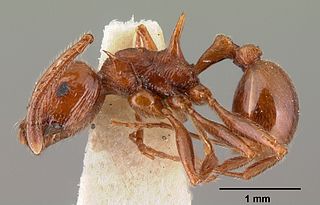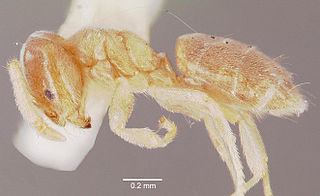Horace St. John Kelly Donisthorpe was an eccentric British myrmecologist and coleopterist, memorable in part for his enthusiastic championing of the renaming of the genus Lasius after him as Donisthorpea, and for his many claims of discovering new species of beetles and ants. He is often considered to be the greatest figure in British myrmecology.

Dolichoderinae is a subfamily of ants, which includes species such as the Argentine ant, the erratic ant, the odorous house ant, and the cone ant. The subfamily presents a great diversity of species throughout the world, distributed in different biogeographic regions, from the Palearctic, Nearctic, Afrotropical region and Malaysia, to the Middle East, Australian, and Neotropical regions.

Anonychomyrma is a genus of ants in the subfamily Dolichoderinae.
Meranoplus parviumgulatus is a species of ant in the genus Meranoplus. It is known from New Guinea and Papua New Guinea.

Pristomyrmex is a genus of ants in the subfamily Myrmicinae.

Chronoxenus rossi is a species of ant of the genus Chronoxenus. It was described by Donisthorpe in 1950.

Leptomyrmecini is a tribe of Dolichoderinae ants with 16 genera and two extinct genera.

Philidris cordata is a species of ant in the genus Philidris. Described by Smith in 1859, the species is endemic to Indonesia and New Guinea. This species is a frequent inhabitant of the ant plant genera: Myrmecodia and Hydnophytum.
Philidris cruda is a species of ant in the genus Philidris. Described by Smith in 1860, the species is endemic to Indonesia.
Philidris jiugongshanensis is a species of ant in the genus Philidris. Described in Wang and Wu in 2007, the species is endemic to China.
Philidris pubescens is a species of ant in the genus Philidris. Described by Donisthorpe in 1949, the species is endemic to New Guinea.
Philidris laevigata is a species of ant in the genus Philidris. Described by Emery in 1895, the species is endemic to Burma, India and China.
Philidris myrmecodiae is a species of ant in the genus Philidris. Described by Emery in 1887, the species is endemic to Asia.
Philidris nagasau is a species of ant in the genus Philidris. Described by Mann in 1921, the species is endemic to Fiji.
Philidris notiala is a species of ant in the genus Philidris. Described by Zhou and Zheng in 1998, the species is endemic to China.
Anonychomyrma gigantea is a species of ant in the genus Anonychomyrma. Described by Donisthorpe in 1943, the species is endemic to New Guinea.
Anonychomyrma longicapitata is a species of ant in the genus Anonychomyrma. Described by Donisthorpe in 1947, the species is endemic to New Guinea.
Anonychomyrma longicapitata is a species of ant in the genus Anonychomyrma. Described by Donisthorpe in 1943, the species is endemic to New Guinea.
Anonychomyrma myrmex is a species of ant in the genus Anonychomyrma. Described by Donisthorpe in 1947, the species is endemic to New Guinea.









